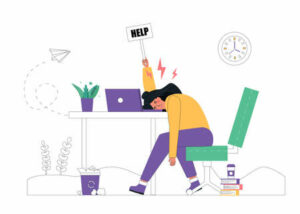1. INTRODUCTION
There are people for whom procrastination is a disruption to life. Procrastination can influence:
- a person’s social status,
- negatively affecting one’s financial situation.
It can take different forms, such as :
→ spending time on social networks instead of working,
→ putting off writing an important report
→ or not doing the necessary shopping for the week.
In addition, procrastinators avoid, delaying things for later. This is how the vicious cycle of stress and procrastination continues to spin.
In this article, we will examine what processes underlie the phenomenon of procrastination and offer some effective strategies for overcoming procrastination.

2. HOW DOES IT WORK ?
Thinking about a task you don’t want to do or can’t do causes great anxiety.
Procrastination provides some short-term relief, but the thought of the work you’ve put off lingers in the back of your mind and doesn’t allow you to rest.
Continuous pressure quickly affects your health – irritability, inattention, headaches, insomnia – these are just some of the effects of task delay. The situation is even worse if procrastination occurs as a result of ADHD, neurosis or depression.
3. WHAT CAUSES PROCRASTINATION ?
Procrastination can be caused by a variety of factors. Among them :
Poor time management (inadequate planning)
Sometimes people procrastinate simply because they haven’t planned their time well and feel overwhelmed by the amount of work they have to do.
They may need a more effective time management strategy to help them stay on track.
Lack of concentration
Some people may find it difficult to focus on a task due to environmental distractions or internal problems, such as anxiety or depression. Procrastination refers to a short-term benefit of avoiding these difficulties.
Lack of interest/motivation
It can be difficult to get motivated to do something that doesn’t seem interesting or doesn’t have any immediate benefit. When people lack intrinsic motivation to do something, it can be easier to procrastinate.
Fear of failure and/or fear of judgment
Fear of failure or criticism can be a major reason why some people procrastinate. They may be afraid that their work is not good enough or that they will not live up to the expectations of others, which may cause them to put off or avoid the task altogether.
Perfectionism
People who have very high standards for themselves may tend to procrastinate because they want to make sure their work is perfect before they hand it in. This can take longer than necessary and prevent them from completing the task on time.
These causes of procrastination can be associated with individual differences in personality, life experiences and cognition, as well as environmental factors such as work demands or family obligations.
It can be helpful for each person to identify the specific causes of their procrastination so that they can find effective strategies to overcome it.
Did you know ?
Research by psychologist Fuschia Sirois shows that regular procrastination can be associated with a variety of mental and physical health problems, such as depression, colds or even cardiovascular disease.
4. LET’S WORK OUT THESE VARIOUS ISSUES TOGETHER ?
Procrastination & ADHD
Can ADHD be the cause of procrastination? People struggling with ADHD have difficulty planning their activities, concentrating, and completing complex or tedious tasks. This is why they quickly become irritated, tend to forget various and even daily matters, and find it difficult to remember important dates.
The disadvantages of ADHD can contribute to procrastination.
Cognitive-behavioral therapy could help. It facilitates the elimination of errors and introduces correct behavior that facilitates better time management.
Anxiety & Procrastination
Anxiety neurosis can be another reason for putting things off.
People who suffer from it experience constant agitation.
- Worry about their own health
- Their safety
- Their family occupies much of their time
They don’t have enough time left to do other things. This also contributes to procrastination.
How to ensure that anxiety is the cause?
It manifests through:
- Fatigue
- Insomnia
- Irritability
- Tension
- Cardiac arrhythmia
- Excessive sweating
Medications and psychotherapy could help treat anxiety. Moreover, it is also important to try to divert the mind from negative thoughts.

Procrastination & depression
Depression is a very serious illness the brain stops functioning rationally due to chimical changes occurring within it. A depressed person has:
- A significant drop in mood
- Overwhelmed by sadness
- Mental fatigue and hopelessness
A characteristic feature is the lack of will and energy and the inability to carry out even the most basic tasks.
For friends and family who have never suffered from depression before, such behavior can be completely incomprehensible. It is often mistaken for apathy or laziness. Sometimes, people react to depression by saying “Pull yourself together!”
However, depression should not be overlooked. It is necessary to consult a professional and start treatment methods, which generally involve taking medications, sometimes in the form of individual sessions with a psychotherapist or group therapy.
Obsessive-Compulsive Disorder & Procrastination
Obsessive-compulsive disorder is closely linked to depression and anxiety.
This type of dysfunction does not allow you to feel satisfied with your task even if it is well done.
It is a feeling somewhat similar to excessive perfectionism. There is always something to improve. Nothing is perfect as it should be.
A person with obsessive-compulsive disorder accumulates negative feelings and thoughts, accompanied by a sense of helplessness and repetitive reflex operations (e.g., cleaning, stacking or swapping objects, washing hands or teeth, etc.). All this limits the person and does not allow them to address issues that should be resolved.
These disorders are treated in the same way – by taking appropriate medication, undergoing cognitive-behavioral therapy, and participating in group work, etc.
Procrastination in a tired person
- Lack of sleep, an abundance of tasks, responsibilities, and short-term stress lead to serious health problems.
Symptoms of fatigue include:
- Exhaustion in the middle of the day and in unexpected circumstances
- Irritability
- Insomnia
- Lack of energy
- Difficulty concentrating

Fatigue is apparently less severe than the dysfunctions mentioned earlier, but neglecting it can lead to serious consequences:
- Autoimmune diseases (diabetes mellitus, Hashimoto’s, systemic lupus erythematosus, rheumatoid arthritis, etc.)
- Myocardial infarction
- Atherosclerosis
- Depression
Sometimes, to avoid fatigue, it is enough to learn to assert oneself and delegate tasks to others. Moreover, when the body is exhausted, it is important to prioritize comfort and the ability to regenerate – maintaining a healthy and balanced diet, exercising, and ensuring a sufficient amount of sleep.
5. IDENTIFY SOLUTIONS
The first thing to do? Identify the reasons for this paralyzing defect.
It is imperative in this case to answer the following questions:
→ Why do I procrastinate and put things off?
→ What kind of things can I put off?
→ What deters me from doing them?
→ Do I have time to accomplish important tasks?
→ Maybe there’s another reason I don’t want to do them?

The Power of Planning
Planning can be a powerful tool to combat procrastination.
By breaking tasks down into smaller steps, it becomes easier to accomplish them. It is also helpful to set clear deadlines for each step, so that you have a clear vision of the task’s progress.
It is important to be realistic in your planning, taking into account time constraints and other tasks to be accomplished.
The importance of motivation
Motivation is a key element in overcoming procrastination. It is important to find compelling reasons to accomplish a task, such as long-term benefits or personal satisfaction.
By focusing on these reasons, it becomes easier to motivate yourself to start and continue the task at hand. It can also be helpful to give yourself rewards for each step you take, such as a break or a treat.
Time management
Effective time management is another important element in overcoming procrastination. It is important to set clear priorities and work on the most important tasks first.
It is also important to take regular breaks to avoid fatigue and stress.
It can be helpful to plan relaxing or leisure activities to recharge between tasks.
6. CONCLUSION
Procrastination can be a frustrating and discouraging obstacle. However, there are effective strategies for overcoming it.
By planning effectively, focusing on motivation, and managing your time efficiently, it is possible to overcome procrastination and accomplish the necessary tasks.
Ultimately, the key is to stay motivated and keep a clear vision of the goal.
